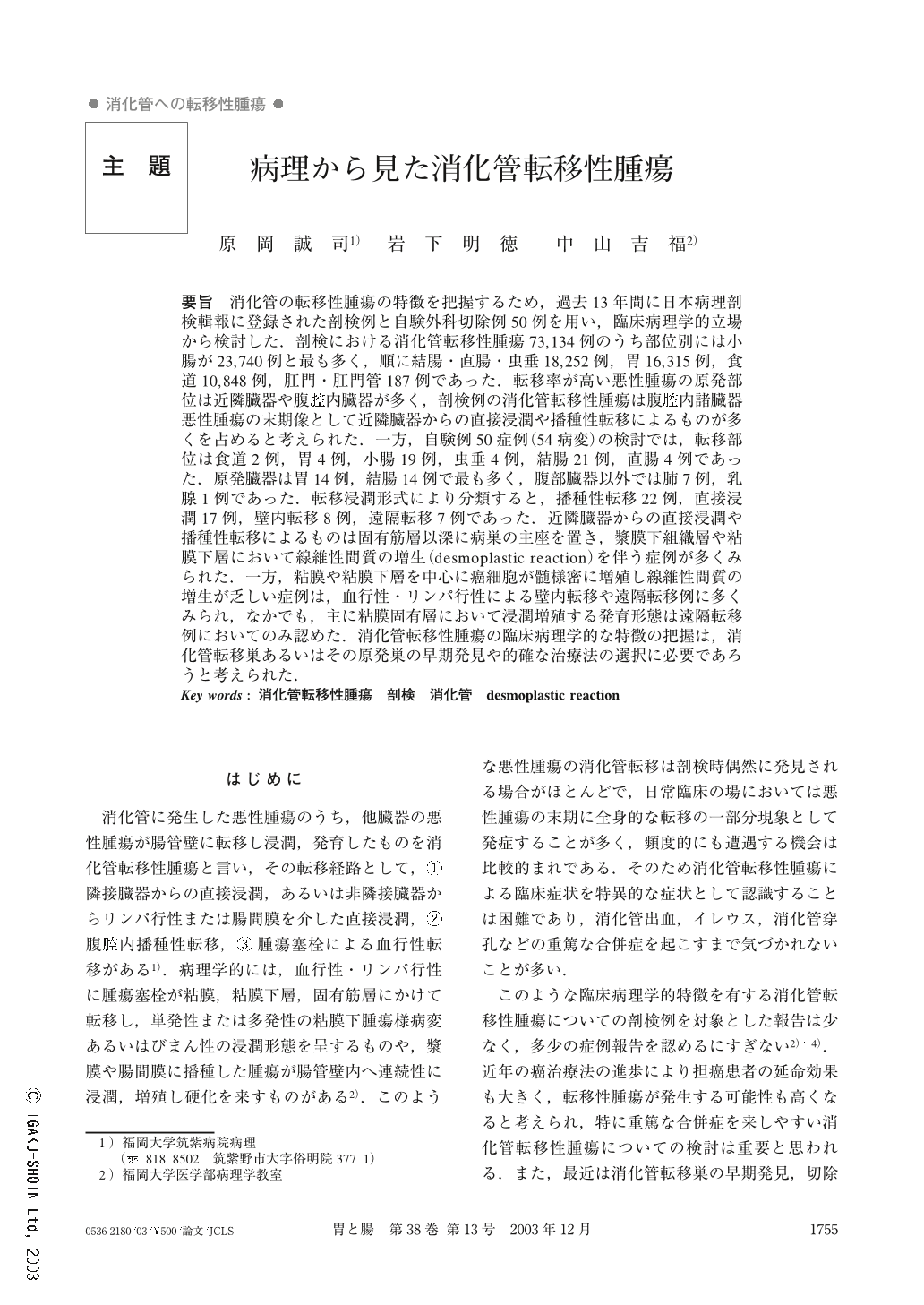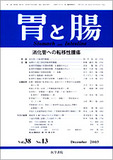Japanese
English
- 有料閲覧
- Abstract 文献概要
- 1ページ目 Look Inside
- 参考文献 Reference
- サイト内被引用 Cited by
要旨 消化管の転移性腫瘍の特徴を把握するため,過去13年間に日本病理剖検輯報に登録された剖検例と自験外科切除例50例を用い,臨床病理学的立場から検討した.剖検における消化管転移性腫瘍73,134例のうち部位別には小腸が23,740例と最も多く,順に結腸・直腸・虫垂18,252例,胃16,315例,食道10,848例,肛門・肛門管187例であった.転移率が高い悪性腫瘍の原発部位は近隣臓器や腹腔内臓器が多く,剖検例の消化管転移性腫瘍は腹腔内諸臓器悪性腫瘍の末期像として近隣臓器からの直接浸潤や播種性転移によるものが多くを占めると考えられた.一方,自験例50症例(54病変)の検討では,転移部位は食道2例,胃4例,小腸19例,虫垂4例,結腸21例,直腸4例であった.原発臓器は胃14例,結腸14例で最も多く,腹部臓器以外では肺7例,乳腺1例であった.転移浸潤形式により分類すると,播種性転移22例,直接浸潤17例,壁内転移8例,遠隔転移7例であった.近隣臓器からの直接浸潤や播種性転移によるものは固有筋層以深に病巣の主座を置き,漿膜下組織層や粘膜下層において線維性間質の増生(desmoplastic reaction)を伴う症例が多くみられた.一方,粘膜や粘膜下層を中心に癌細胞が髄様密に増殖し線維性間質の増生が乏しい症例は,血行性・リンパ行性による壁内転移や遠隔転移例に多くみられ,なかでも,主に粘膜固有層において浸潤増殖する発育形態は遠隔転移例においてのみ認めた.消化管転移性腫瘍の臨床病理学的な特徴の把握は,消化管転移巣あるいはその原発巣の早期発見や的確な治療法の選択に必要であろうと考えられた.
In order to grasp the characteristic features of metastatic tumor of the gastrointestinal tract, 73,134 autopsy cases registered with a nationwide pathologic autopsy database in Japan and 50 surgical specimens encountered at our institute in the past 13 years were studied from the standpoint of clinicopathology. The autopsy series revealed that metastasis to the small intestine occurred most frequently in the gastrointestinal tract. The incidence of metastasis to the small intestine, colon/rectum/vermiform appendix, stomach, oesophagus, anal canal was 8.53 %, 6.56 %, 5.86 %, 3.90 %, 0.07 %, respectively. The primary site of malignant tumor that has a high incidence of metastasis to the gastrointestinal tract was mostly a neighboring organ or an intraabdominal organ. Therefore, most metastatic tumors of the gastrointestinal tract in autopsy case seems to be attributable to direct invasion or disseminated metastasis from a neighboring organ, reflecting the end stage of a malignant tumor of an intra-abdominal organ. Among the malignant tumors of the extra-abdominal organ, the incidence of metastasis of lung cancer to the stomach, small intestine and large intestine was high. On the other hand, examination of the 50 surgical cases (54 lesions) revealed that metastatic tumors of the gastrointestinal tract had developed in 2 cases of the oesophagus, 4 cases of the stomach, 19 cases of the small intestine, 4 cases of the vermiform appendix, 21 cases of the colon, and in 4 cases of the rectum. The most common primary lesions were in the stomach and colon, with 14 cases each. The primary tumors of extra-abdominal organs were lung cancer in 7 cases and breast cancer in 1 case. The most common histological cell type of a primary tumor was adenocarcinoma (42/54, 77.8%). The histological type of the primary tumor of lung cancer was anaplastic carcinoma (large cell carcinoma) in 5 cases and adenocarcinoma in 2 cases. According to the classification of pathways of spread and metastasis of tumors, the cases were classified as disseminated metastasis (22 cases), direct invasion (17 cases), intramural metastasis (8 cases), and distant metastasis (7 cases). The most common microscopic features of the metastatic tumors resulting from direct invasion from a neighboring organ or intraperitoneal seeding were the proliferation of carcinoma cells mainly in the deeper portion from the muscularis propria accompanied with stromal fibrosis (desmoplastic reaction) in the submucosa and subserosal layer. On the other hand, the solid proliferation of carcinoma cells arranged in medullary pattern with scant fibrous stroma in the mucosa and submucosal layer was the microscopic feature observed in many cases classified as intramural metastasis and distant metastasis via lymphatic or blood vessel permeation. It was especially noted that the solid growth pattern in the mucosa was presented only in cases of distant metastasis. In conclusion, to grasp the characteristic clinicopathological features of tumors of the gastrointestinal tract is necessary for detecting whether or not they are metastatic tumors, and also for locating the primary site of the metastasis. To discover this in the early stages of disease helps in the choice of a precise and effective therapy.

Copyright © 2003, Igaku-Shoin Ltd. All rights reserved.


